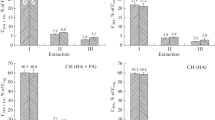Abstract
The arylsulfatase activity of soil and humic arylsulfatase complexes extracted from soil were measured using the substrates p-nitrophenyl sulfate and low molecular weight (500–10000) soil ester sulfate compounds. Soil samples from the Aphorizon of a Podzol from S-amended wheat plots and a Regosol from dykeland hayfield plots were investigated. Soil arylsulfatase activity (assayed with p-nitrophenyl sulfate) in the fall was significantly higher than spring samples; however, no seasonal differences were observed when humic-arylsulfatase complexes were assayed with p-nitrophenyl sulfate. The discrepancy between arylsulfatase activity in soil and soil extracts was probably due to inhibitors which were found in soil materials. These results appear to support the theory that abiotic arylsulfatase is a relatively stable and persistent component of soil. There was a marked difference in the response by humic-arylsulfatase complexes to the artificial substrate p-nitrophenyl sulfate and natural low molecular weight soil substrates. Humic-arylsulfatase complexes hydrolysed 35–80% of added low molecular weight substrates depending on the treatment. The molecular size, concentration, and chemical composition of the low molecular weight ester sulfate compounds affected hydrolysis of the low molecular weight substrates. The response by humic-arylsulfatase complexes to the chromogenic ester sulfate, p-nitrophenyl sulfate did not reflect the ability of these complexes to hydrolyse natural soil substrates. In an experiments we examined arylsulfatase activity and soil S status in relation to the total S in plant tissue and grain from wheat plants grown in the Podzol. Tissue S was more strongly associated with soil S than the wheat grain. Hydriodic acid-S, Ca(H2PO4)2-extractable sulfate, and hydrolysable ester sulfates in the high molecular weight (>10000) and low molecular weight (500–10000) fractions of soil organic matter extracts were strongly positively correlated with tissue S. Arylsulfatase activity in soil and humic-arylsulfatase extracts assayed with p-nitrophenyl sulfate were also strongly correlated with tissue S, while humic-arylsulfatase activity assayed with the low molecular weight substrate was negatively correlated with tissue S.
Similar content being viewed by others
References
Abramyan SA, Galstyan ASh (1987) Regulation of the activity of sulfur-metabolism enzymes in soil. Pochvovedeniye 9:61–70
Appiah MR, Ahenkorah Y (1989) Arylsulfatase activity of different latosol soils of Ghana cropped to cocoa (Theobroma cacao) and coffee (Coffea canephora var. robusta). Biol Fertil Soils 7:186–190
Alewell C (1993) Effects of organic sulfur compounds on extraction and determination of inorganic sulfate. Plant and Soil 149:141–144
Bardsley C, Lancaster JD (1960) Determination of reserve sulfur and soluble sulfates in soils. Soil Sci Soc Proc 24:265–268
Burns RG (1983) Extracellular enzyme-substrate interactions in soil. In: Slater JH, Whittenbury R, Wimpenny JWT (eds) Microbes in their natural environments. 34th Symposium of the Society for General Microbiology. Cambridge University Press, Cambridge, pp 249–298
Burns RG (1986) Interactions of enzymes with soil mineral and organic colloids. In: Huang PM, Schnitzer M (eds) Interactions of soil minerals with natural organics and microbes. Spec Publ 17, Soil Sci Soc Am, Madison, Wis, pp 429–451
Cooper PJM (1972) Arylsulfatase activity in northern Nigerian soils. Soil Biol Biochem 4:333–337
Dodgson KS, White GF, Fitzgerald JW (1982) Sulfatases of microbial origin. Vol I. CRC Press, Boca Raton, Fla
Fitzgerald JW, Strickland TC (1987) Mineralization of organic sulphur in the O2 horizon of a hardwood forest: Involvement of sulphatase enzymes. Soil Biol Biochem 19:779–781
Fitzgerald JW, Watwood ME, Rose FA (1985) Forest floor and soil arylsulfatase hydrolysis of tyrosine sulfate, an environmentally relevant substrate for the enzyme. Soil Biol Biochem 17:885–887
Freney JR (1986) Forms and reactions of organic sulfur compounds in soils: In: Tabatabai MA (ed) Sulfur in agriculture. Soil Sci Soc Am, Madison, Wis, pp 207–232
Houghton C, Rose FA (1976) Liberation of sulfate from sulfate esters by soils. Applied Environ Microbiol 31:969–976
Jarvis BW, Lang GE, Wieder RK (1987) Arylsulfatase activity in a peat exposed to acid precipitation. Soil Biol Biochem 19:107–109
Kiss S, Drăgan-Bularda M, Rădulescu D (1975) Biological significance of enzymes accumulated in soil. Adv Agron 27:25–87
Lou G, Warman PR (1992) Enzymatic hydrolysis of ester sulfate in soil organic matter extracts. Biol Fertil Soils 14:112–115
Lou GQJ, Warman PR (1994) Characterization of ester sulfate in a gypsum-amended Podzol using an immobilized sulfatase reactor. Biol Fertil Soils 17:276–280
Mahler RJ, Maples RL (1987) Effect of sulfur additions on soil and the nutrition of wheat. Commun Soil Sci Plant Anal 18:653–673
McGill WB, Cole CV (1981) Comparative aspects of cycling of organic, C, N, S, and P through soil organic matter. Geoderma 26:267–286
Pettit NM, Lindsay JG, Freedman RB, Burns RG (1977) Differential stabilities of soil enzymes: Assay and properties of phosphatase and arylsulfatase. Biochem Biophys Acta 485:357–366
Sarathchandra SU, Perrot KW (1981) Determination of phosphatase and arylsulfatase activities in soils. Soil Biol Biochem 13:543–545
SAS Institute Inc (1990) SAS procedures guide, version 6, 3rd edn. SAS Institute, Cary, NC
Simon-Sylvestre G (1965) Annual evolution of sulfur in soil compared to that of nitrogen. CR Séances Acad Agric Fr 53:90–96
Sinsabaugh RS (1994) Enzymic analysis of microbial pattern and process. Biol Fertil Soils 17:69–74
Speir TW, Ross DJ (1990) Temporal stability of enzymes in a peatland soil profile. Soil Biol Biochem 22:1003–1005
Tabatabai MA, Bremner JM (1970a) Arylsulfatase activity of soils. Soil Sci Soc Am Proc 34:225–229
Tabatabai MA, Bremner JM (1970b) Factors affecting soil arylsulfatase activity. Soil Sci Soc Am Proc 34:427–429
Warman PR, Sampson HG (1994) Effect of sulfur additions on the yield and elemental composition of canola and spring wheat. J Plant Nutr 17:1817–1825
Whalen JK, Warman PR (1996) Examination of ester sulfates in Podzolic and Regosolic soils using an immobilized arylsulfatase reactor. Biol Fertil Soils (to appear)
Williams CH (1967) Some factors affecting the mineralization of organic sulfur in soils. Plant and Soil 26:205–223
Author information
Authors and Affiliations
Rights and permissions
About this article
Cite this article
Whalen, J.K., Warman, P.R. Arylsulfatase activity in soil and soil extracts using natural and artificial substrates. Biol Fertil Soils 22, 373–378 (1996). https://doi.org/10.1007/BF00334586
Received:
Issue Date:
DOI: https://doi.org/10.1007/BF00334586




